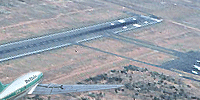 |
 |
|
||||
|
By
Wikipedia,
The Armstrong Whitworth Argosy was a British three-engine biplane airliner built by Armstrong Whitworth Aircraft and operated by Imperial Airways from 1926 to 1935. DevelopmentThe Armstrong Whitworth A.W.15 Argosy stemmed from a declaration by Imperial Airways that all its aircraft would be multi-engine designs on the grounds of safety . They were intended to replace the older single-engine de Havilland aircraft that Imperial Airways had inherited from its constituent companies, mainly Daimler Airway. The first example (G-EBLF) flew in March 1926following an initial order for three Argosies from Imperial Airways. An improved Mk. II version was introduced in 1929. Operational HistoryThe Argosy was initially used on European routes (later operating on services to South Africa), with the fleet named after cities. Argosies implemented the world's first "named" air service, the luxury 'Silver Wing' service from London to Paris, in Argosy City of Birmingham (G-EBLO). Two seats were removed and replaced with a bar and a steward was in attendance. Three Argosies were lost during service with Imperial Airways, with one being written off in a forced landing near Aswan and one during a training accident, both in 1931, with no injuries in either accident. On 28 March 1933, however, an Argosy caught fire over Belgium , causing a crash in which all three crew and 12 passengers were killed . Argosies continued in service with Imperial Airways until 1935, with the last example G-AACJ "City of Manchester" being used for joy-riding by United Airways Ltd of Stanley Park Aerodrome (Blackpool), which then became British Airways Ltd. It continued in use with British Airways until December 1936. Variants
OperatorsImperial Airways Argosy fleet 1926-1935
Specifications (Argosy II)Data from {British Civil Aircraft since 1919} General characteristics
Performance
Text from Wikipedia is available under the Creative Commons Attribution/Share-Alike License; additional terms may apply.
Published in July 2009. Click here to read more articles related to aviation and space!
|
||||||||||||||||||||||||||||||||||||||||||||||||||||||||||||||||||||||||

 |
|
Copyright 2004-2025 © by Airports-Worldwide.com, Vyshenskoho st. 36, Lviv 79010, Ukraine Legal Disclaimer |